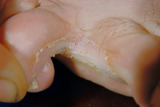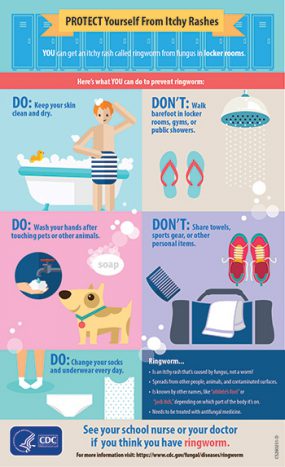Ringworm is a common skin infection that is caused by a fungus. It’s called “ringworm” because it can cause a circular rash (shaped like a ring) that is usually red and itchy. Anyone can get ringworm. The fungi that cause this infection can live on skin, surfaces, and on household items such as clothing, towels, and bedding.
Ringworm goes by many names. The medical terms are “tinea” or “dermatophytosis.” Other names for ringworm are based on its location on the body – for example, ringworm on the feet is also called “athlete’s foot.”
About
Ringworm is a common infection of the skin and nails that is caused by fungus. The infection is called “ringworm” because it can cause an itchy, red, circular rash. Ringworm is also called “tinea” or “dermatophytosis.” The different types of ringworm are usually named for the location of the infection on the body.
Areas of the body that can be affected by ringworm include:
- Feet (tinea pedis, commonly called “athlete’s foot”)
- Groin, inner thighs, or buttocks (tinea cruris, commonly called “jock itch”)
- Scalp (tinea capitis)
- Beard (tinea barbae)
- Hands (tinea manuum)
- Toenails or fingernails (tinea unguium, also called “onychomycosis”)
- Other parts of the body such as arms or legs (tinea corporis)
Approximately 40 different species of fungi can cause ringworm; the scientific names for the types of fungi that cause ringworm are Trichophyton, Microsporum, and Epidermophyton.
Symptoms
Ringworm can affect skin on almost any part of the body as well as fingernails and toenails. The symptoms of ringworm often depend on which part of the body is infected, but they generally include:
- Itchy skin
- Ring-shaped rash
- Red, scaly, cracked skin
- Hair loss
Symptoms typically appear between 4 and 14 days after the skin comes in contact with the fungi that cause ringworm.
Symptoms of ringworm by location on the body:
- Feet (tinea pedis or “athlete’s foot”): The symptoms of ringworm on the feet include red, swollen, peeling, itchy skin between the toes (especially between the pinky toe and the one next to it). The sole and heel of the foot may also be affected. In severe cases, the skin on the feet can blister.
- Scalp (tinea capitis): Ringworm on the scalp usually looks like a scaly, itchy, red, circular bald spot. The bald spot can grow in size and multiple spots might develop if the infection spreads. Ringworm on the scalp is more common in children than it is in adults.
- Groin (tinea cruris or “jock itch”): Ringworm on the groin looks like scaly, itchy, red spots, usually on the inner sides of the skin folds of the thigh.
- Beard (tinea barbae): Symptoms of ringworm on the beard include scaly, itchy, red spots on the cheeks, chin, and upper neck. The spots might become crusted over or filled with pus, and the affected hair might fall out.
Risk & Prevention
Who gets ringworm?
Ringworm is very common. Anyone can get ringworm, but people who have weakened immune systems may be especially at risk for infection and may have problems fighting off a ringworm infection. People who use public showers or locker rooms, athletes (particularly those who are involved in contact sports such as wrestling), people who wear tight shoes and have excessive sweating, and people who have close contact with animals may also be more likely to come in contact with the fungi that cause ringworm.
How can I prevent ringworm?
- Keep your skin clean and dry.
- Wear shoes that allow air to circulate freely around your feet.
- Don’t walk barefoot in areas like locker rooms or public showers.
- Clip your fingernails and toenails short and keep them clean.
- Change your socks and underwear at least once a day.
- Don’t share clothing, towels, sheets, or other personal items with someone who has ringworm.
- Wash your hands with soap and running water after playing with pets. If you suspect that your pet has ringworm, take it to see a veterinarian. If your pet has ringworm, follow the steps below to prevent spreading the infection.
- If you’re an athlete involved in close contact sports, shower immediately after your practice session or match, and keep all of your sports gear and uniform clean. Don’t share sports gear (helmet, etc.) with other players.
My pet has ringworm and I’m worried about ringworm in my house. What should I do?
Ringworm can easily transfer from animals to humans. You can take the following steps to protect yourself and your pet:
For people
Do
- Wash your hands with soap and running water after playing with or petting your pet.
- Wear gloves and long sleeves if you must handle animals with ringworm, and always wash your hands after handling the animal.
- Vacuum the areas of the home that the infected pet commonly visits. This will help to remove infected fur or flakes of skin.
- Disinfect areas the pet has spent time in, including surfaces and bedding.
- The spores of this fungus can be killed with common disinfectants like diluted chlorine bleach (1/4 c per gallon water), benzalkonium chloride, or strong detergents.
- Never mix cleaning products. This may cause harmful gases.
Do not handle animals with ringworm if your immune system is weak in any way (if you have HIV/AIDS, are undergoing cancer treatment, or are taking medications that suppress the immune system, for example).
For pets
Protect your pet’s health
- If you suspect that your pet has ringworm, make sure it is seen by a veterinarian so treatment can be started.
- If one of your pets has ringworm, make sure you have every pet in the household checked for ringworm infection.
There’s a ringworm outbreak in my child’s school/daycare center. What should I do?
- Contact your local health department for more information.
- Tell your child not to share personal items, such as clothing, hairbrushes, and hats, with other people.
- Take your child to see a pediatrician if he or she develops ringworm symptoms.
- Check with your child’s school or daycare to see if he or she can still attend classes or participate in athletics.
How Ringworm Spreads
The fungi that cause ringworm can live on skin and in the environment. There are three main ways that ringworm can spread:
1. From a person who has ringworm.
People can get ringworm after contact with someone who has the infection. To avoid spreading the infection, people with ringworm shouldn’t share clothing, towels, combs, or other personal items with other people.
2. From an animal that has ringworm.
People can get ringworm after touching an animal that has ringworm. Many different kinds of animals can spread ringworm to people, including dogs and cats, especially kittens and puppies. Other animals, like cows, goats, pigs, and horses can also spread ringworm to people.
3. From the environment.
The fungi that cause ringworm can live on surfaces, particularly in damp areas like locker rooms and public showers. For that reason, it’s a good idea not to walk barefoot in these places.
Diagnosis and testing for Ringworm
How is ringworm diagnosed?
Your healthcare provider might suspect you have ringworm by looking at the affected skin and asking questions about your symptoms. Your healthcare provider will generally take a small skin scraping or nail sample to examine under a microscope or send to a laboratory for further testing.
Treatment for Ringworm
Athlete's foot can usually be treated with non-prescription medication applied to the skin.
The treatment for ringworm depends on its location on the body and how serious the infection is. Some forms of ringworm can be treated with non-prescription (“over-the-counter”) medications, but other forms of ringworm need treatment with prescription antifungal medication.
- Ringworm on the skin like athlete’s foot (tinea pedis) and jock itch (tinea cruris) can usually be treated with non-prescription antifungal creams, lotions, or powders applied to the skin for 2 to 4 weeks. There are many non-prescription products available to treat ringworm, including:
- Clotrimazole (Lotrimin, Mycelex)
- Miconazole (Aloe Vesta Antifungal, Azolen, Baza Antifungal, Carrington Antifungal, Critic Aid Clear, Cruex Prescription Strength, DermaFungal, Desenex, Fungoid Tincture, Micaderm, Micatin, Micro-Guard, Miranel, Mitrazol, Podactin, Remedy Antifungal, Secura Antifungal)
- Terbinafine (Lamisil)
- Ketoconazole (Xolegel)
For non-prescription creams, lotions, or powders, follow the directions on the package label. Contact your healthcare provider if your infection doesn’t go away or gets worse.
- Ringworm on the scalp (tinea capitis) usually needs to be treated with prescription antifungal medication taken by mouth for 1 to 3 months. Creams, lotions, or powders don’t work for ringworm on the scalp. Prescription antifungal medications used to treat ringworm on the scalp include:
- Griseofulvin (Grifulvin V, Gris-PEG)
- Terbinafine
- Itraconazole (Onmel, Sporanox)
- Fluconazole (Diflucan)
You should contact your healthcare provider if:
- Your infection gets worse or doesn’t go away after using non-prescription medications.
- You or your child has ringworm on the scalp. Ringworm on the scalp needs to be treated with prescription antifungal medication.
Source: Centers for Disease Control and Prevention
Last updated : 9/26/2023